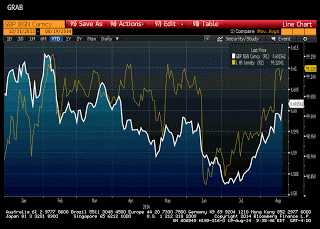Forward guidance is the practice by which central banks try to shape investor expectations for the trajectory of monetary policy.  Central banks have come to increasing rely on it.  BOE Governor Carney appeared to have effectively used it when he was heading up the Bank of Canada.   The kind of forward he had adopted there was date specific.  He gave the market some indication when the excess capacity in the economy would be absorbed.  This, in turn, helped generate interest rate expectations.
Subsequently, Carney’s successor was forced to push further out the time frame, and abandoned all together the temporal signal a rate hike.  Still. the greater irony of Carney’s tenure at the BOE is that the grounds of his selection–ostensibly more activist then his predecessor King and more inclined to support economy while the government stuck to its fiscal austerity rhetoric–proved unnecessary.  From almost Carney’s first day at the BOE, the UK economy has shown unexpected vigor.
The forward guidance, for which Carney was regarded as the maestro, has proven to be confusing and contradictory. Â The “temporal inconsistencies”, a euphemism for self-contradictory guidance, does not appear to be a cause of consternation for policy makers. Â It has helped stop the sterling rally, which itself was tantamount to some tightening of monetary conditions. Â It also has help inject more volatility into sterling. Â The 3-month implied volatility had fallen to record lows below 5% in early June, and has now held above its 100-day moving average for the first time in six months.

We have been highlighting the sensitivity of sterling to shifting interest rate expectations since May.  In this Great Graphic, created on Bloomberg, we chart the dollar against sterling, so as the dollar rises against sterling (sterling falls against the dollar), the white line rises.  The yellow line is the March 2015 short-sterling futures.  It is like the Eurodollar futures contract.  As the yellow line rises, the implied 3-month rate next March falls.Â

